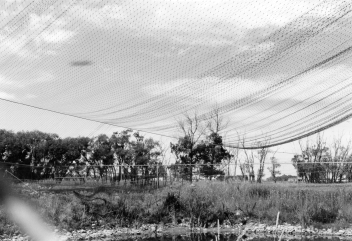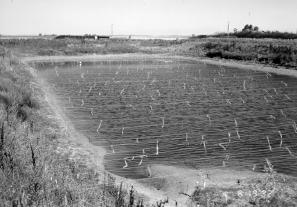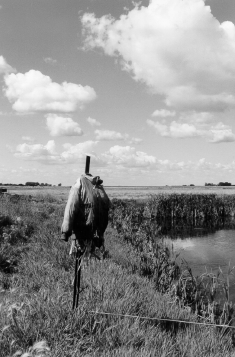| | Birds, fish and mammals are known predators of cultured fish. Bird predation is the major source of fish loss at aquaculture facilities. Predatory fish can also be a major concern to fish stocks, followed by mammal predation to a much lesser extent.
The diversity of Alberta's aquaculture practices as well as the variety of predators means producers need to understand damage prevention and control techniques. These control measures may be used singly or in combination to alleviate predation problems.
Assessing predation losses
Determining the extent of your fish losses to predation will dictate the amount of money and resources you invest in control measures. For predatory birds, yearly fish consumption can be estimated by using species-specific feeding rates. The following formula may be used to estimate the number of fish consumed per year:
average number of birds observed per hour x bird feeding rate (fish taken per hour) x hours birds are present per day x days birds are present per year.
Several counts should be taken daily during the damage season, as bird numbers vary throughout the day and over a given season.
Predation protection measures
Cultured fish can be more or less susceptible to bird predation depending on the physical location, design and construction of an aquaculture facility. Facility location, design and construction
- locating aquaculture sites near known bird migratory routes or flyways will mean more visits and/or predation
- when aquaculture facilities are located in isolated areas, heavy losses of fish can result when birds have easy access to fry and fingerlings
- man-made and natural objects, such as fences, telephone and light poles or vegetation, provide attractive perching, hiding, nesting and hunting structures for bird predators. Try to reduce the number of these structures around the aquaculture facility
- increasing the pond's shore water depth to a minimum of 1 m and steepening embankments will decrease predatory birds' ability to feed
Stocking
- stock ponds or raceways with larger fingerlings. This approach will decrease predation levels because larger fish are usually less vulnerable to predation
- reducing the number of fish in a structure may reduce its attractiveness to bird predation, as birds prefer densely stocked ponds.
- when stocking ponds, release fingerlings at several locations in open water, which will decrease the chance of fingerling mortality due to weed entanglement and/or bird predation
- the use of stocking cages for up to two weeks can help prevent fish mortality caused by weeds, predatory birds and toxic bottom water
- fish that feed at the water's surface are more susceptible to predation; avoid floating feed if possible
- stocking at dusk provides a greater opportunity for fish to adapt to new surroundings.
Bird identification
Bird predation at aquaculture facilities can have a significant economic impact on operations. Besides consuming fish, birds can injure fish, disrupt their feeding activity, disturb broodstock and contribute to the spread of diseases and parasites in aquaculture ponds. Open water and high fish stocking densities at aquaculture facilities are natural attractants to many bird species.
When controlling bird predators, take action in early spring, before feeding habits or nearby nesting sites have been established. Prompt action will encourage the birds to seek nesting habitat elsewhere.
Observing bird hunting and feeding can confirm the damage to your aquaculture site. Fish are often swallowed whole, leaving few direct signs of damage behind. In these cases, the presence of bird excrement (whitewash), bird feathers and/or footprints may be the only signs of predation. To understand potential damage and to implement proper bird control methods, you need to correctly identify the bird species.
Great Blue Heron and the Black-crowned Night Heron (the waders)
The Great Blue Heron is the most common predator of cultured trout in Alberta. Easily identified, the heron's body is about 120 cm in length and colored slate blue or grey. Its head is white with a pattern of black stripes and streaks, and the lower neck and breast has a ruffle of long, thin, hanging feathers. The heron wades in shallow water and spears or grabs its prey. Predation usually occurs during dusk and dawn. One heron can consume an average of 2 live trout per hour, or roughly 0.35 kg/day. Average prey size is under 25 cm in length, but herons can take prey up to 35 cm.
The Black-crowned Night Heron is a medium-sized bird averaging 30 cm in length. Adults have a black crown and back, grey wings and a white neck and underbelly. They are mainly fish eaters, feeding at dusk and dawn. Black-crowned Night Herons consume fish at a rate of 0.15 kg/day.
Mergansers, Cormorants and Grebes (the swimmers)
Three species of Mergansers common in Alberta include the Hooded, Red-Breasted and the Common Merganser. Mergansers are medium-size birds, averaging 45 cm in length and have slender, spike-like bills with a hooked tip. Plumage varies with sex: males appear mostly black and white while females appear grey and brown. Mergansers feed on small fish during the day by diving from the surface and pursuing fish underwater. Fish can be consumed at a rate of 0.14 kg/day.
The Double-crested Cormorant is a large (75-100 cm in length), uniformly dark plumaged bird. Cormorants have a long snakelike neck and a hooked bill. They inhabit open, larger bodies of water where they fish by diving from the surface. They can consume roughly 0.23 to 0.45 kg of fish per day.
Grebes common in Alberta include: Pied-billed Grebe, Horned Grebe, Eared Grebe, Western Grebe and the Red-necked Grebe. Grebes vary in size from 32-65 cm in length. Both sexes are similar in plumage but may differ in size, with the male often being larger. The plumage is dense and silky and is usually brown or gray. Grebes are known to feed mostly on aquatic invertebrates, but they will consume fish feed.
Gulls, Osprey and Kingfishers (the fliers)
The Ring-billed Gull, California Gull, Franklin's Gull and Herring Gull are all residents of Alberta. Gulls range from 30 to 60 cm in length and are white, grey or black. Gulls can quickly become habituated and may be difficult to frighten from stocked dugouts. Newly stocked fingerlings are especially vulnerable to gull predation. Gulls are known to alight on the water, taking small and often sick or dead fish from the surface. Consumption rates are estimated at 0.10 to 0.15 kg/day.
The Osprey is the main avian predator of larger fish. Commonly called a fish hawk, the osprey has a long body (60 cm) and a wingspan of 135 to 180 cm. They can be found nesting on dead trees, utility poles, pylons and floating buoys. Osprey may only be present for a few weeks of the year but can take up to 2 fish per hour (30-60 cm long). Average consumption rate has been estimated at 0.23 kg/day.
The Belted Kingfisher is approximately 30 cm long, easily recognized by the white band separating the dark head from the gray body. An efficient predator of small fish, the Belted Kingfisher forages throughout the day. It dives midair, then plunges headfirst into the water to capture fish. The Belted Kingfisher is capable of consuming fish at a rate of 0.10 kg/day.
Note: All birds that may cause predation problems are protected by the Migratory Birds Convention Act of Canada (MBCA). Permits from Natural Resources Service of Alberta Environmental Protection must be obtained before trapping or removing these birds. Harming protected birds or destroying their nests and eggs without a permit is a Federal offence.
Predation management
The only assurance of eliminating bird predation at aquaculture facilities is total exclusion of birds from fish holding facilities. However, total exclusion may be impractical for many facilities, due to size of operation, expense, or interference with management activities. Satisfactory results may be obtained with the use of partial exclusion and non-exclusion barriers, if combined with other control methods.
Which control method(s) to use depends on a number of factors, including the number and species of birds involved, the severity of the predation problem, and the type and size of facility to be protected.
1. Barriers
Two types of physical barriers can be used for managing bird predation:
- complete enclosures that prevent predators from gaining access
- partially-covered systems that interfere with the feeding behaviour of predators
Complete enclosures - exclude all predators
Complete enclosure (caging) of ponds and/or raceways with screens or nets.
- all exclusion structures should be long-lasting and strong enough to withstand the weight of several large birds. They should keep the barrier from sagging to within the bird's striking distance to the water
- the barrier should be visible to birds to minimize accidental injury or entrapment
- exclusion structures should allow for facility maintenance, feeding, harvesting and other operations
- total exclusion is the only method that can provide long-term control against all bird predators

Figure 1. Partially covered system using overhanging net

Figure 2. Partially covered system using overhead line/wire and flagging
Partially covered systems - interferes with predators feeding behaviour
Partially covered systems include overhead wire, line, net, screens, perimeter fencing and devices that discourage birds from entering the facility (Figure 1 and Figure 2).
- overhead lines and wires - heavy gauge monofilament lines, high-tensile galvanized or stainless steel wire suspended in a grid pattern or in one direction over the water surface
- spacing between wires or lines varies with bird species
- overhead line/wire systems are most effective against flying predators such as terns, gulls, cormorants and ospreys
- wading birds can access ponds by landing on shore and walking to the water. These areas should also be protected by perimeter fencing
Electric wires and perimeter fencing
- charges must be non-lethal to humans and birds.
- fences used in combination with overhead lines/wires may be successful at deterring both wading and flying predators
2. Frightening techniques
Frightening devices and techniques discourage birds from feeding, roosting or gathering at a location. Frightening techniques rely on sight and/or sound stimuli to discourage birds from remaining at a site by making the birds believe the site is dangerous for them. Success in frightening birds away depends on the number of devices used, how and where they are administered and if their use precedes the establishment of the birds' feeding habits.
- frightening techniques are most applicable for short duration problems (1 to 3 days), as birds will quickly lose their initial fear
- start the frightening regime before the birds establish regular feeding patterns
- change the location of frightening devices often, particularly noise-making ones
- long term results may be achieved by using a combination of methods and by frequently alternating the devices used
Noise
- noise devices should start and stop at varying intervals and be moved to various locations frequently
- distress calls - recording of species-specific distress calls, should be used as soon as birds arrive
- cracker shells - modified cartridges that contain a firecracker fired from a shotgun
- whistle bombs, screamers, screamer rockets, bangers - 15 mm cartridges fired into the air from a hand-held .22 caliber pistol
- automatic exploders - propane gas or acetylene gas is used to operate a small canon equipped with an electronic timing mechanism, which emits loud explosions at adjustable time intervals
Visual scare devices
A variety of visual devices are available for scaring night-feeding birds. As with noise-making devices, the effectiveness of visual scare devices is often short term, as birds quickly become accustomed to them. These devices are more effective when used in combination with other methods.
Scarecrows and predator models
- models or silhouettes of humans and/or predators placed in strategic locations at a facility (Figure 3)
- change location of models and silhouettes frequently
- effectiveness increases with the addition of pyrotechnics fired from the same area

Figure 3. Scarecrow model placed adjacent to dugout
Lights
- construction flashers, area lights, revolving beacons and strobe lights
- a variety of light-emitting devices can be used to confuse, frighten, temporarily blind and interfere with activities of night-feeding birds
Predatory fish
Prior to stocking, drain or net ponds to remove fish eating species such as the Northern Pike. Northern Pike are opportunistic feeders and will generally attack anything they can swallow whole, which can be as much as 50 per cent of their body weight. Barrier screening on both the inlet and outlet of the pond is usually effective for keeping out larger fish. See Agdex 485/87-1, Screening Your Fish Pond.
Mammal predators
Chewed or partially eaten fish may be a sign of predatory mammals at an aquaculture facility. Mink are usually the most problematic of animal predators found at stocked dugouts in Alberta. The racoon, skunk and otter can cause problems in some areas but to a much lesser extent.
Any problems with predatory mammals should be reported to your local Natural Resources Officer, to ensure proper control measures are taken.
Alberta Agriculture and Food does not endorse or promote any products mentioned in this factsheet.
References
Alberta Fish and Wildlife, Game Fish Farming Fact Sheet Number 6.
Andelt, William F.., Timothy P. Woolley and Stuart N. Hopper. 1997. Effectiveness of barriers, pyrotechnics, flashing lights, and Scarey Manr for deterring heron predation on fish. Wildlife Society Bulletin, 25(3):686-694.
Aquaculture in Saskatchewan: Dugouts and Ponds, Fisheries Branch, Saskatchewan Environment and Resource Management. 20 pp
Bird Predation and Its Control at Aquaculture Facilities in the Northeastern United States. United States Department of Agriculture Animal and Plant Health Inspection Service. 17 pp.
Gorenzel, W.P., F.S. Conte and T.P. Salmon. 1994. Bird Damage at Aquaculture Facilities. Prevention and Control of Wildlife Damage University of Nebraska. Lincoln, United States Department of Agriculture, and the Great Plains Agricultural Council. E5-E23.
Kevan, S.D. and P.G. Kevan. 1993. Bird Predators at Ontario Fish Farms. Enviroquest Ltd. Order No. 93-049, August, Agdex 484.
Kevan, Sherrene D. 1992. A Review of Methods to Reduce Bird Predation on Land-Based Fish Farms. Canadian Wildlife Service Conservation and Protection. Nepean: Unpublished report.
Stickley, Allen J. 1990. Avian predators on southern aquaculture. Southern Regional Aquaculture Center Publication No. 400. 8 pp.
Source: Agdex 485/685-1. December 1999. |
|